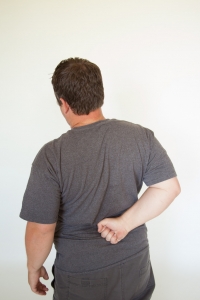 Just about everyone has experienced back pain at some point. It may be a minor ache, a stabbing sensation when you move a certain way, or a severe radiating pain that has kept you bedridden for days or weeks. Pain in any area of the back is an indication that something is amiss, but a lack of pain doesn’t mean that everything is perfectly fine. Some people with severe scoliosis have reported little to no back pain, while those with only one minor subluxation (spinal misalignment) have been in debilitating pain.
Just about everyone has experienced back pain at some point. It may be a minor ache, a stabbing sensation when you move a certain way, or a severe radiating pain that has kept you bedridden for days or weeks. Pain in any area of the back is an indication that something is amiss, but a lack of pain doesn’t mean that everything is perfectly fine. Some people with severe scoliosis have reported little to no back pain, while those with only one minor subluxation (spinal misalignment) have been in debilitating pain.
Back pain is one of the main reasons people begin seeing a chiropractor, and although it’s unpleasant, back pain is a great tool for getting you in the door of your Lithia Springs chiropractor’s office and getting you on the road to better health and a better life.
Back Pain Can Be an Indication of Something More
Back pain is usually the result of a subluxation, or a misalignment of the spine. When one vertebra is twisted or pushed to one side, the muscles have to make up for the lack of balance, and that often results in sore back muscles. A minor subluxation can easily be corrected with a chiropractic adjustment. However, when subluxations are incredibly severe or if they are left unresolved, they can lead to many other issues in your body—not just in your back.
The spine protects the spinal cord, which all nerves in the body are connected to. All those nerves are also connected to your organs. So when a subluxation is present and interfering with nerve function, it then interferes with organ function as well.
Pain is usually one of the last symptoms to present itself when there is a problem in the body, so back pain may very well be an indication of some other current or future issue within your body. That’s why it’s extremely important that you visit a chiropractor whenever you have back pain and continue to stay under chiropractic care even when your symptoms have subsided. The goal is not just to have a lack of pain, but to have proper and optimal function throughout your entire body.
Chiropractic Care Is the Best Solution for Back Pain
Since chiropractors spend their entire school career learning about the spine, they should be your number one choice when it comes to combatting back pain. Sure, medication will make the pain disappear for a while, and surgery may promise you immediate relief, but neither of those options gets to the source of the issue and seek to fix the problem from the inside out. Additionally, you won’t see any side effects or long-term problems from being under chiropractic care. You’ll only see reduced pain, increased quality of life, and improved health. And who wouldn’t want all that?
If you’re tired of suffering from back pain and you’re ready for a permanent, drug-free solution, contact Lithia Springs chiropractor Dr. Bolar and his team at Vital Life Chiropractic. They will set you up with a consultation and educate you on all the benefits of chiropractic care, and then they will get you feeling great and functioning properly!
Sources
Berner, N., Capoferri, D. “Complete Cervical Kyphosis Correction and Resolution of Low Back Pain Utilizing Pierce Technique.” Journal of Vertebral Subluxation Research, 2011 Nov: 183-188. https://livingvitallife.com/wp-content/uploads/2018/03/Complete-Cervical-Kyphosis-Correction-and-Resolution-of-Low-Back-Pain-Utilizing-Pierce-Technique-1.pdf.
Fedorchuk, C., Campbell, C. “Improvement in a Soldier with Urinary Urgency and Low Back Pain Undergoing Chiropractic Care: A Case Study and Selective Review of the Literature.” Journal of Vertebral Subluxation Research, 2010 April: 1-5. https://livingvitallife.com/wp-content/uploads/2018/03/Improvement-in-a-Soldier-with-Urinary-Urgency-and-Low-Back-Pain-Undergoing-Chiropractic-Care-1.pdf.
Mattson, R. “Resolution of Chronic Back, Leg and Ankle Pain Following Chiropractic Intervention and the Use of Orthotics.” Journal of Vertebral Subluxation Research, 2008 March: 1-4. https://livingvitallife.com/wp-content/uploads/2018/03/Resolution-of-Chronic-Back-Leg-and-Ankle-Pain-Following-Chiropractic-Intervention-and-the-Use-of-Orthotics-1.pdf.
